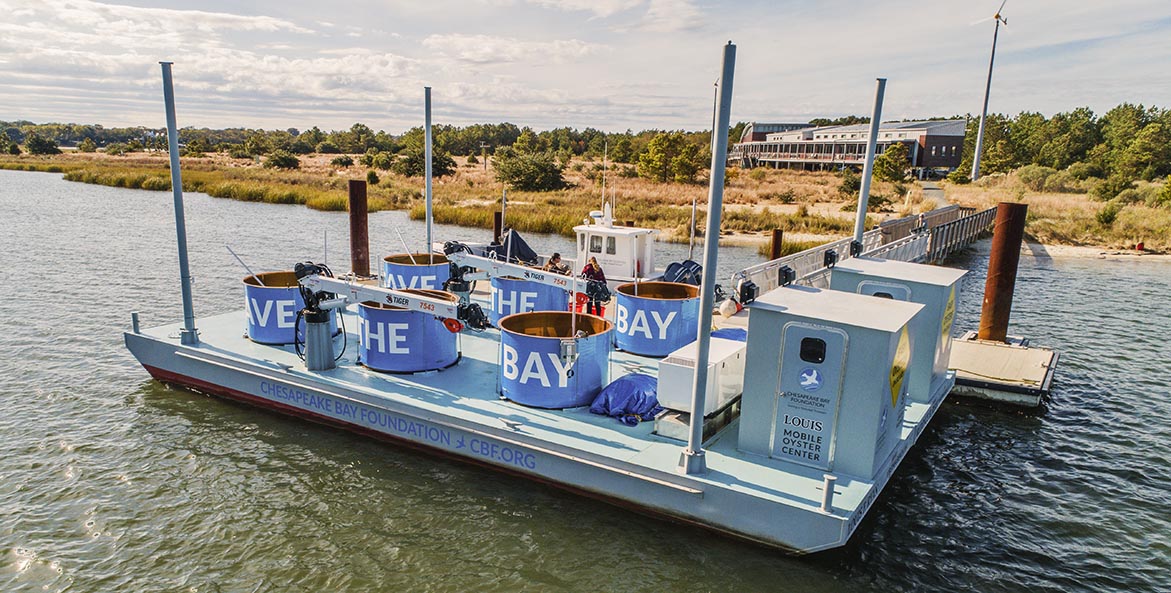The program includes producing baby oysters (called spat), transplanting oysters on reefs, training and supporting local residents to raise oysters, and recycling oyster shell to be used on future reefs.
CBF’s Virginia oyster restoration program’s mission is to:
- Leverage greater public and private investment in the Baywide oyster restoration effort.
- Engage citizens, students and decision makers in hands-on oyster restoration activities.
- Create public awareness of the critical need to restore oysters.
- Develop partnerships with community groups, institutions, agencies and organizations.
- Serve as a platform for education and scientific research.
- Produce oysters for local reef restoration projects.
- Promote commercial oyster aquaculture.
- Work with oyster processors, growers and watermen to develop innovative ways to sustain the industry.
Download our 2022 Virginia Oyster Restoration Annual Report
Where Do We Work?
Brock Environmental Center (Virginia Beach)
The Brock Environmental Center, located at Pleasure House Point in Virginia Beach, Virginia, serves as a main hub for mobilizing oyster restoration work. We utilize the Brock Environmental Center campus, as well as many others across Virginia, for numerous oyster restoration volunteer activities that include:
- Shell Recycling
Oyster shells are the foundation of many oyster restoration projects, but they are in short supply. Through CBF’s shell recycling program shells from restaurants, and oyster roasts are reclaimed for restoration projects. Find out more about shell recycling. - Shell Bagging
Shell bagging is a crucial step in our oyster restoration process. Before recycled oyster shells can be placed in our setting tanks, they must be cured (left in the sun to dry out) and bagged. “Shell jigs” are used to make the process more efficient. This activity requires many hands and our Virginia oyster restoration staff rely on hard-working volunteers to help us prepare for spat on shell production. - Reef Ball Production
Reef balls are concrete structures that look like igloos and are used to create aquatic habitat for oysters and many other species. Volunteers assist CBF staff with producing two sizes of reef balls that are deployed by boat or by hand on restoration sites. - Oyster Gardening
The CBF Oyster Gardening program trains hundreds of citizens to grow and care for spat on shell oysters at their dock or other approved locations in tidal waters throughout Virginia. Training is held at several accessible locations. Gardeners then take their oysters and grow them in cages provided by CBF for about one year before returning them to be planted on local reefs and adopting another batch.
Find out more about becoming a Virginia oyster gardener.
Prudence H. & Louis F. Ryan Mobile Oyster Restoration Center (Virginia Beach)
CBF's cutting-edge vessel has changed how we bring back the Chesapeake Bay's native oyster population. This innovative oyster barge holds six 850-gallon tanks for setting oyster larvae on recycled shells and reef balls. The barge travels from one river to the next, allowing CBF to restore local oyster populations more efficiently than ever before. The Mobile Oyster Center is currently located at the Brock Environmental Center. Find out more about the mobile oyster restoration center.
Restoration Vessel Chesapeake Gold
Another unique aspect of CBF’s Virginia oyster program is the innovative oyster restoration vessel Chesapeake Gold. The Chesapeake Gold is used primarily for transporting millions of spat on shell and hundreds of reef balls annually. The shallow-draft workboat is also used to monitor oyster reefs at low tide. Among the vessel's highlights is its small boom crane which is used to lift and deploy reef balls at restoration sites



